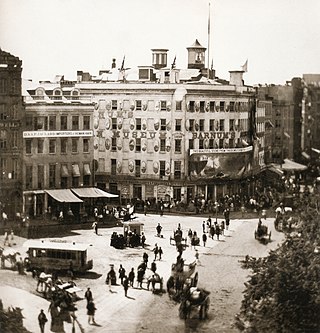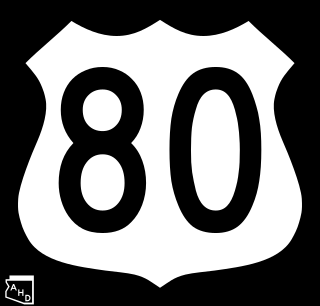
Phoenix is the capital and most populous city of the U.S. state of Arizona, with 1,662,607 residents as of 2024. It is the fifth-most populous city in the United States and the most populous state capital in the country.

U.S. Route 66 or U.S. Highway 66 was one of the original highways in the United States Numbered Highway System. It was established on November 11, 1926, with road signs erected the following year. The highway, which became one of the most famous roads in the United States, ran from Chicago, Illinois, through Missouri, Kansas, Oklahoma, Texas, New Mexico, and Arizona before terminating in Santa Monica in Los Angeles County, California, covering a total of 2,448 miles (3,940 km).

Interstate 10 (I-10) is the southernmost transcontinental highway in the Interstate Highway System. I-10 is the fourth-longest Interstate in the United States at 2,460.34 miles (3,959.53 km), following I-90, I-80, and I-40. This freeway is part of the originally planned network that was laid out in 1956, and its last section was completed in 1990.

Interstate 19 (I-19) is a north–south Interstate Highway located entirely within the US state of Arizona. I-19 travels from Nogales, roughly 90 meters (300 ft) from the Mexican border, to Tucson, at I-10. The highway also travels through the cities of Rio Rico, Green Valley, and Sahuarita.

Gila Bend, founded in 1872, is a town in Maricopa County, Arizona, United States. The town is named for an approximately 90-degree bend in the Gila River, which is near the community's current location. As of the 2020 census, the population of the town was 1,892.

U.S. Route 80 or U.S. Highway 80 (US 80) is a major east–west United States Numbered Highway in the Southern United States, much of which was once part of the early auto trail known as the Dixie Overland Highway. As the "0" in the route number indicates, it was originally a cross-country route, from the Pacific Ocean to the Atlantic Ocean. Its original western terminus was at Historic US 101 in San Diego, California. However, the entire segment west of Dallas, Texas, has been decommissioned in favor of various Interstate Highways and state highways. Currently, the highway's western terminus is at an interchange with Interstate 30 (I-30) on the Dallas–Mesquite city line. Its eastern terminus is in Tybee Island, Georgia, near the Atlantic Ocean. Between Jonesville, Texas, and Kewanee, Mississippi, US 80 runs parallel to or concurrently with Interstate 20. It also currently runs through Dallas, Texas; Shreveport, Louisiana; Jackson, Mississippi; Montgomery, Alabama; Columbus, Georgia; Macon, Georgia; and Savannah, Georgia.

A pet cemetery is a cemetery for pets. Although the veneration and burial of beloved pets has been practiced since ancient times, burial grounds reserved specifically for animals were not common until the late 19th century.

Interstate 60 is a 2002 American independent road film written and directed by Bob Gale, in his directorial debut, and starring James Marsden, Gary Oldman, Amy Smart, Christopher Lloyd, Chris Cooper, Amy Jo Johnson, Art Evans, Ann-Margret and Kurt Russell, with a cameo by Michael J. Fox. It involves a trip to the fictional town of Danver, Colorado.

A roadside attraction is a feature along the side of a road meant to attract tourists. In general, these are places one might stop on the way to somewhere, rather than being a destination. They are frequently advertised with billboards. The modern tourist-oriented highway attraction originated as a U.S. and Canadian phenomenon in the 1940s to 1960s, and subsequently caught on in Australia.

Santa Claus is an uninhabited desert place in Mohave County, Arizona, United States. Originating in 1937, Santa Claus lies approximately 14 miles (23 km) northwest of Kingman, Arizona, along U.S. Route 93 between mile markers 57 and 58, immediately north of Hermit Drive and just south of both Grasshopper Junction, Arizona, and the Junk Art of Chloride, a group of metal statues in Chloride, Arizona, that include a flamingo made out of a motorcycle gas tank. Characterized in 1988 as "a little roadside place on the west shoulder of U.S. Route 93," Santa Claus receives traffic from motorists driving between Phoenix, Arizona, and Las Vegas, Nevada, or Hoover Dam.
Nut Tree is a lifestyle center in Vacaville, California near the intersection of Interstate 80 and Interstate 505.

The historic U.S. Route 66 (US 66) ran east–west across the central part of the state of New Mexico, along the path now taken by Interstate 40 (I-40). However, until 1937, it took a longer route via Los Lunas, Albuquerque, and Santa Fe, now roughly New Mexico State Road 6 (NM 6), I-25, and US 84. Large portions of the old road parallel to I-40 have been designated NM 117, NM 118, NM 122, NM 124, NM 333, three separate loops of I-40 Business, and state-maintained frontage roads.

Barnum's American Museum was a dime museum located at the corner of Broadway, Park Row, and Ann Street in what is now the Financial District of Manhattan, New York City, from 1841 to 1865. The museum was owned by famous showman P. T. Barnum, who purchased Scudder's American Museum in 1841. The museum offered both strange and educational attractions and performances. Some were extremely reputable and historically or scientifically valuable, while others were less so.
The metropolitan area of Phoenix in the U.S. state of Arizona contains one of the nation's largest and fastest-growing freeway systems, with over 1,405 lane miles (2,261 km) as of 2005.

U.S. Route 80 (US 80), also known as the Ocean-to-Ocean Highway, the Broadway of America and the Jefferson Davis Memorial Highway, was a major transcontinental highway that existed in the U.S. state of Arizona from November 11, 1926, to October 6, 1989. At its peak, US 80 traveled from the California border in Yuma to the New Mexico state line near Lordsburg. US 80 was an important highway in the development of Arizona's car culture. Like its northern counterpart, US 66, the popularity of travel along US 80 helped lead to the establishment of many unique roadside businesses and attractions, including many iconic motor hotels and restaurants. US 80 was a particularly long highway, reaching a length of almost 500 miles (800 km) within the state of Arizona alone for most of the route's existence.

Bowlin Travel Centers, Inc. is a New Mexico–based family owned company that operates a chain of roadside convenience stores and travel centers found on highways in the American southwest. The stores are located primarily in the U.S. states of Arizona and New Mexico; their corporate headquarters are located in Albuquerque. The company's Chief Executive Officer is Michael L. Bowlin.
Thomas Prince may refer to:

The Dixie Overland Highway was an auto trail across the southern United States. It was conceived in July 1914 by the Automobile Club of Savannah, which envisioned a practical all-year driving route from Georgia to California. It was originally developed as a cross-country route, from the Pacific Ocean to the Atlantic Ocean making history as the first ever ocean to ocean highway route. In 1925, the federal Joint Board on Interstate Highways created U.S. Route 80, largely following the route of the Dixie Overland Highway.
Homer Tate (1884–1975) was an American nicknamed the "King of Gaffes" for devising strange "artifacts" that were often used in roadside attractions and sideshows to fool and amuse the public. Among his best known works is The Thing.
Love Has Won (LHW), also known as the Galactic Federation of Light and Joy Rains, is an American new religious movement which was led by Amy Carlson until her death in 2021. Carlson was referred to within the group as "Mother God", who described herself as, among other things, the creator of the universe. The group has been described as a cult by many, including ex-members and media outlets. The group had between twelve and twenty full-time members who lived with Carlson at the time of her death.















